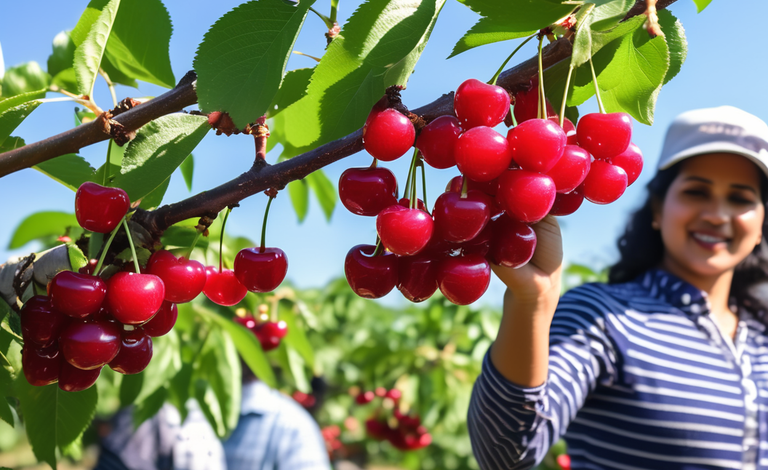Cherry Farming in India: Complete Guide For Beginners

Cherry cultivation in India is witnessing a significant upswing, thanks to modern horticultural practices and governmental support.
Cherry trees grow in the country’s northern regions, especially in Jammu & Kashmir, Himachal Pradesh, and Uttarakhand. With the support of several initiatives and the integration of state-of-the-art technology, the cherry market is anticipated to grow significantly.
This blog will cover the essentials of cherry farming, such as soil and climate requirements, propagation techniques, and cost considerations.
Varieties Of Cherries Grown In India
Several varieties of cherries are grown in India in regions including Uttarakhand, Himachal Pradesh, and Jammu & Kashmir. The most popular varieties of sweet cherry are Lapins, Bing, Rainier, and Stella.
Additionally, there are sour cherries, often referred to as Montmorency but less prevalent. There are tiny, sour, wild cherries called Prunus Cerasoides and Prunus Avium in the Himalayan region. Some Indian cherries, such as Regina and Kordia, are hybrids, a cross between sweet and sour cherries.
Factors Responsible For Cherry Farming In India
The Ideal Planting and Harvesting Seasons
Cherry plants are typically planted in late fall or early winter. Harvesting seasons vary by region, with cherries generally ready for picking from late April to mid-June. Early planting allows for root system establishment before the hotter months.
Climatic Conditions and Soil Requirements
Cherries, being temperature-sensitive, grow in cool weather conditions with temperatures ranging from 15°C to 25°C during the growing season. A crucial prerequisite is winter dormancy with temperatures below 7°C to induce flowering. Well-draining soil rich in organic matter, with a pH between 6.0 to 7.5, is optimal for cherry cultivation. Farmers can enhance soil fertility by adding compost or manure before planting.
Intercropping and Management Practices
Intercropping proves beneficial in cherry cultivation. Legumes like peas and beans, along with leafy vegetables such as spinach and lettuce, are suitable companions. Effective pest and disease management are imperative, given the susceptibility of cherries to issues like cherry fruit fly, powdery mildew, and bacterial canker.
Planting and Propagation
Cherry trees are commonly propagated through grafting onto rootstocks. The winter months, from December to February, are ideal for planting. Grafting involves uniting a scion of the desired variety with a compatible cherry tree rootstock. Other methods include budding, cuttings, and layering.
Tractors like Preet tractor help in the planting process, helping farmers cover larger areas efficiently.
Plant Density and Spacing
Cherry plants are spaced 12 to 20 feet apart, with a density of 150 to 250 trees per acre. High-density planting techniques can increase density to 700 trees per acre.
Weed Control
There are three methods to keep the weeds away from cherry plants. First is hand weeding, where people pull out the weeds by hand using tools like hoes or sickles.
Second is mulching, which means covering the ground around the cherry plants with stuff like straw, sawdust, plastic, or a weed mat. Third is using chemicals called herbicides to control weeds, either before they show up or after.
Fertilizer Schedule
For healthy cherry trees, here’s a simple plan. Before planting, add well-rotted manure or compost to the soil. In the first year, give each tree 100 grams of nitrogen, phosphorus, and potassium, split into two doses in March and September.
In the second year, it increases to 200 grams, split into three doses in March, June, and September. For mature trees, maintain 400-500 grams yearly, divided into three doses in March, June, and September.
Irrigation and Pruning
Cherry trees need regular watering when they’re young. Drip irrigation is the best irrigation method. Using nutrients like nitrogen, phosphorus, and potassium in the right amounts helps them grow well.
Harvesting And Post Harvesting
Cherries are picked from May to June and handled delicately by hand to prevent damage. After sorting and grading, they’re stored in cool, dry places at 0-2°C. Post-harvest cherries are washed, pre-cooled, and packed in suitable material.
For transport, they’re moved in refrigerated containers, possibly using Kubota tractor, to keep them at the right temperature during the journey, ensuring they stay in good shape until they reach their destination.
Cherry Yield and Profit
The average yield per tree ranges from 15 to 20 kg, with gross income per acre between 562,500 to 750,000 INR. Net profit after expenses is approximately 382,500 INR per acre.
The Final Thoughts
With an increased demand and a suitable growing environment, cherries are popularly grown in India. Cherry farming has been a profitable business for ages. Additionally, cherry production adopts modern methods and makes use of existing resources, it can be profitable and significantly improve the agricultural landscape of the country. As the sector grows, cherries could become a pleasant success story for Indian farmers.


